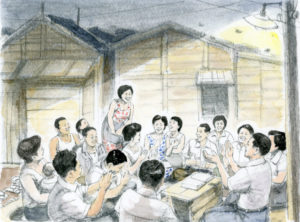Chapter Summary

Illustration courtesy of Seikyo Press.
On a tract of reclaimed land jutting into Japan’s Hakata Bay, there was a shantytown that the locals called Dokan, which was considered a rough, unsafe area, inhabited by people who ended up there due to various severe hardships. As the momentum of the Soka Gakkai’s propagation efforts accelerated toward the goal of 3 million households, many people in this area, too, began practicing Nichiren Buddhism. This led to countless dramas of ordinary people revitalizing their lives.
Shin’ichi’s guidance and encouragement from fellow members gave these new members the strength to transform their lives. The Soka Gakkai sought to revitalize ordinary people throughout the country and transform modern society at its core.
At the February Headquarters Leaders Meeting, it was announced that the Soka Gakkai had achieved unprecedented monthly propagation results in January. Shin’ichi sought to nurture the new members by dedicating himself to supporting their study of Nichiren Buddhism. He traveled to the Chugoku and Shikoku regions to encourage the members there. And on April 2, he participated in a memorial service commemorating four years since Josei Toda’s passing. Citing the passage “When great evil occurs, great good follows” (“Great Evil and Great Good,” The Writings of Nichiren Daishonin, vol. 1, p. 1119), Shin’ichi expressed his determination to continue advancing kosen-rufu.
The Soka Gakkai’s 24th General Meeting, held on May 3, marked the second anniversary of Shin’ichi’s inauguration as its president, opening new pathways for kosen-rufu. He voiced his resolve, stating, “Let us make the Soka Gakkai the pillar of Japan and advance with indestructible unity for the happiness of the people and prosperity of society” (The New Human Revolution, vol. 6, p. 179).
Unforgettable Scene

Illustration courtesy of Seikyo Press.
The Mission of Buddhists Is to Contribute to Society
At the Hokkaido General Chapter Leaders Meeting on April 15, 1962, Shin’ichi Yamamoto spoke about the mission of Buddhists.
Shin’ichi explained why the Soka Gakkai had formed the Clean Government [Komei] Political Federation and was fielding candidates to run for public office. “There has been some public criticism as to why a religious organization like the Soka Gakkai is backing candidates for government office on the local and national level,” he said. “Today, I want to take this opportunity to clarify this.
“As Buddhists, we uphold the teachings of Buddhism. But we are also citizens, of Japan and our local communities, who have a duty to participate in government and take responsibility for our country’s direction. We would be selfish and neglectful of our civic duty if we showed no interest in politics and instead concerned ourselves only with our personal happiness and benefit.
“Today’s government turns its back on the weak and disadvantaged in our society and does nothing to aid the people in a true sense. This is what has prompted us to support public office members committed to working for the people’s happiness and welfare based on the compassionate principles of Buddhism. Such activities in no way constitute either direct intervention in politics by a religious group or an ambition to govern for the Soka Gakkai’s benefit.
“In our ongoing efforts to fulfill our mission as Buddhists, we actively address various issues to create a society where all can live happily and securely” …
Shin’ichi had continued to press forward calmly amid the relentless barrage of criticism directed at the Soka Gakkai. He personally bore the full brunt of all attacks and energetically rebutted the detractor’s charges. His sole concern—the objective of his brave, tireless efforts—was to encourage and inspire the members. (NHR-6, 164–65)
Key Passage
Leaders have to cast aside all selfishness and vanity, becoming strongly determined to devote themselves fully to the members. This is the true, correct way to practice Buddhism. (NHR-6, 155)
You are reading {{ meterCount }} of {{ meterMax }} free premium articles

